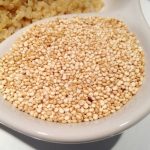Did your dog just throw up an unusual white foam? There are several explanations for this and you will be surprised that some of them don’t require a visit to the vet. However, there are cases when a dog vomits white foam and you have to see the vet for assistance. Read on to know what you can do in case this happens.
Reason #1: It’s a Simple Indigestion
Most dogs have that strange habit of swallowing stuff they are not supposed to eat. There are dogs who eat their toys, grass, and even household items. A dog throwing up white foam possibly ate something off-limits and his system is attempting to get rid of the strange stuff. If it is just a case of a simple stomach upset, it should be fixed on its own.
In cases like this, it will be helpful to avoid feeding the dog for 12 hours. Some vets even recommend fasting for an entire day, depending on the severity of the stomach upset. Because his gastrointestinal system is not yet working properly, giving the dog something to eat could make his stomach worse.
You only have to ensure that your pet is well-hydrated throughout the fasting period. Make sure that he has access to fresh and clean water while you withhold food. You might need to see the veterinarian, though, in case the vomiting is associated with diarrhea and retching. If the vomiting persists for more than a day and the pets display apparent pain, it should be addressed immediately to prevent it from developing into serious problems.
If you suspect the dog swallowed an indigestible object like plastic, you should contact your veterinarian as soon as possible. Items that got stuck on the esophagus warrant surgical removal and intestinal obstruction can be life-threatening.
Reason #2: It’s a Symptom of Reflux Gastritis
Acid reflux in dogs occurs when there is an unrestricted reverse flow of intestinal fluids going to the tube that bridges the esophagus and the throat. While it can happen to dogs of any age, puppies often suffer from this more compared to adult dogs.
There are several types of medical treatments available for dogs with reflux gastritis. Sucralfate is a gastrointestinal protectant used against stomach acid. In many cases, vets also recommend anti-emetic medications. Metoclopramide is an example of a prescription drug used for treating reflux in canines.
Reason #3: It’s a Sign of Kennel Cough
As the name suggests, this respiratory disease often occurs in crowded places such as kennels or boarding facilities. Still, it can be acquired in any place because it’s airborne. A canine can also spread it to other dogs through direct contact and by being exposed to infected surfaces.
The most common sign of kennel cough is a cough characterized by a honking sound. It is often associated with sneezing, runny nose, inappetence, and sneezing. A dog diagnosed with mild kennel cough should have a full rest for roughly a couple of weeks. In advanced stages, the dog may be administered antibiotics as per a vet’s advice. This is to avoid any secondary infection from happening.
Make sure that your pet has all the core vaccines because he can use them as protection from viral and bacterial diseases such as the kennel cough. Disinfecting your pet’s things also prevents the spread of bacteria. Make it a point that your dog’s crate, bowl, and even his bed is clean at all times.
Reason #4: It’s a Symptom of Rabies
Throwing white foam is among the signs of a dog infected with rabies. Other symptoms include restlessness, apparent behavioral changes, a need to attack other pets and even humans, as well as constant chewing and licking. Your pet might be infected if he shows a big change in his usual dispositions.
However, this is not the case if your dog’s vaccines are up to date. In the first place, it is important that your dog has up to date vaccines since it’s required by the law. When you have doubts, it’s still best to visit your vet. Contrary to popular belief, rabies is not only transmitted from a bite of an infected animal. Even a simple scratch inflicted by a dog with rabies can also infect your own pet.
If you just adopted a dog, you have to secure his vaccination records. This is to make sure that your new pet gets all the required vaccines for his age. This is why it’s important to adopt a pet from licensed breeders because they ensure all the vaccines are done before turning over the dog to his new owners. Don’t settle for breeders without certification and licenses who make their transactions online.
Reason #5: The Dog Might Have Kidney Problems
Canines with progressing kidney disease throw up white foam because there is an increase in the ammonia levels in their organs. This should be seen or treated immediately before it causes gastric irritation. There are a lot of symptoms that come with this. The leading indicator is polydipsia or excessive thirst.
If you suspect your dog is suffering from kidney disease, better bring him to the doctor as soon as you can so he could undergo a blood examination. This will show if there is an abnormality in the balance of calcium and phosphorous in your dog’s body. An imbalance of these two minerals is also among the signs of kidney disease.
There are a lot of medications given to pets with kidney disease because a number of health problems, such as metabolic issues and infections also arise from problems with this organ. Dogs suffering from kidney disease need a special diet. The recommended diet for them is one low in sodium. It is also necessary to give them lots of fresh water to combat dehydration.
Reason #6: The Dog Suffers from Bloating
Gastric Dilatation and Volvulus (GDV) or bloating is a serious condition considered as a type of medical emergency. Aside from vomiting white foam, bloating is also characterized by restlessness, a swollen stomach, and drooling. If these symptoms occur, you have to bring your pet to the nearest animal hospital as this condition can be deadly when left untreated.
There is no known cause of bloating but certain things can put your pet at risk of developing this condition. One of these is consuming a single large meal in a day. Prevent this from happening by giving your dog two meal servings per day of appropriate amounts.
The quantity of your pet’s meals depends on his size. If your pet weighs 12 lbs. or less, you can give him 1/3 to one cup of food per day. For those who are on a heavier side, like canines over 100 lbs., the recommended amount is roughly 4 cups for every feeding.
Reason #7: The Dog Drank Large Quantities of Water
Vomiting foam can happen when the dog drank more water than the amount he normally drinks. In some cases, it’s because your pet drank water shortly after physical activity. However, if he has been drinking excessively for a while, this may be a symptom to an underlying problem.
The water requirement for dogs is 1 ounce for each pound of body weight. Do note that the size is not the only factor you should consider. Your pet’s activity level also matters when determining the appropriate amount of water per day.
Excessive thirst is often associated with kidney disease, although it is also a sign of diabetes mellitus. For some dogs, the increased thirst is due to Cushing’s disease or having adrenal glands that produce too much cortisol.
In case your dog has been drinking a lot, don’t attempt to lessen his water intake just to solve the issue. Not giving him enough water could only result in dehydration, which can put your animal’s life at risk. If you have a lot of doubts and want to fix it immediately, better set an appointment with your veterinarian.
This way, you can have the peace of mind that any underlying issue will be treated right before it turns into something more serious or even fatal. Besides, it is advisable that you keep an eye on your dog because excessive thirst is usually associated with complicated health problems.
The Bottom Line
Keep an eye when the dog throws up white foam. More often than not, it’s just a cause of a simple indigestion but there are cases when it’s a sign of a bigger health problem. You will eventually need to schedule an appointment with your vet if the vomiting comes with any other symptoms such as diarrhea and excessive thirst.






















